 W
WThe flag of Acre is one of the official symbols of the state of Acre, Brazil. The current flag was introduced by Law No. 1170 of 22 December 1995 (pt), adopting the design of the flag of the Republic of Acre, as modified by Resolution No. 5 of 24 January 1921. The faixa governamental (pt) used by the Chief Executive of Acre is made up of the colors of the flag, and also boasts the red star.
 W
WThe flag of Baton Rouge is the city flag of Baton Rouge, capital city of Louisiana. It has a red field with a small shield and cursive text reading "Baton Rouge". The current flag was adopted in 1995 by the city council, replacing an older flag that had been in use since 1968.
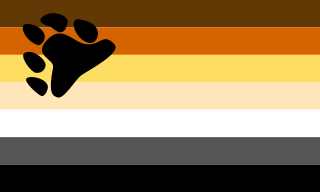 W
WThe International Bear Brotherhood Flag was designed to represent the bear subculture within the LGBT community. The colours of the flag are meant to include the colours of the furs of animal bears throughout the world, not necessarily referring to human skin and hair colour tones: Dark brown, orange/rust, golden yellow, tan, white, gray, and black. The flag was designed with inclusion in mind. The gay bear culture celebrates secondary sex characteristics such as growth of body hair and facial hair, which is typically considered a "bear" trait.
 W
WThe national flag of Belarus is a red-and-green flag with a white-and-red ornament pattern placed at the hoist (staff) end. The current design was introduced in 2012 by the State Committee for Standardisation of the Republic of Belarus, and is adapted from a design approved in a May 1995 referendum. It is a modification of the 1951 flag used while the country was a republic of the Soviet Union. Changes made to the Soviet-era flag were the removal of communist symbols – the hammer and sickle and the red star – as well as the reversal of the colours in the ornament pattern. Since the 1995 referendum, several flags used by Belarusian government officials and agencies have been modelled on this national flag.
 W
WThe flag of Buenos Aires was originally designed in 1580, but it was officially adopted on October 24, 1995. It shows the coat of arms of the House of Habsburg, as the flag has an eagle on a white background. The use of Habsburg symbols comes from Charles V of the Habsburg dynasty, who was king of Spain when Buenos Aires was originally founded in 1536. The city was eventually abandoned, but it was refounded in 1580, during the reign of Charles V's son, Philip II.
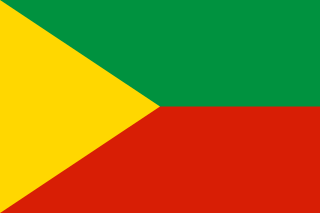 W
WThe flag of Chita Oblast, a former federal subject of the Russian Federation, is a horizontal green and red bicolour charged with a yellow chevron. It was adopted on December 22, 1995.
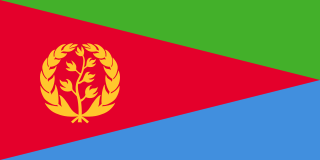 W
WThe flag of Eritrea, is the national flag of Eritrea. It was adopted on December 5, 1995. The flag combines the basic layout and colors from the flag of the Eritrean People's Liberation Front with an emblem of a wreath with the upright olive-branch derived from the 1952–1962 flag. The green color in the flag stands for the agriculture and livestock of the country, the blue represents the bounty of the sea, and the red stands for the blood shed in the struggle for Eritrean independence with the 30 leaves in the wreath representing the thirty years spent in the struggle.
 W
WThe flag of Evenk Autonomous Okrug, in the Russian Federation, is a horizontal tricolor of light blue, white, and dark blue, all of which stand for the polar days and nights in Northern Siberia. It is charged in the center by a red kumalan, the solar emblem in Evenki culture.
 W
WThe flag of Gagauzia has served as an official symbol of the Gagauz Territorial Unit since 1995, and is recognized as a regional symbol by Moldova. Popularly known as the "Sky Flag", it is a triband of blue-white-red, with a wider blue stripe, charged with three yellow stars arranged in triangular pattern. The overall symbolism is debated, but the stars may represent the three Gagauz municipalities within Moldova. The tricolor is reminiscent of the Russian flag, which is also popular in Gagauzia; the issue has created friction between Gagauz and Moldovan politicians.
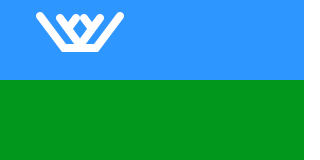 W
WThe flag of Khanty-Mansi autonomous okrug, in the Russian Federation, is a rectangular field arranged with two strip at even proportions. A vertical white strip is attached to the fly side of the flag. A stylized crown at the upper hoist side is charged on the azure strip.
 W
WThe flag of Krasnodar Krai, in the Russian Federation, is a horizontal tricolour of blue, pink and green charged with the golden coat of arms of Krasnodar Krai.
 W
WThe flag of Mordovia, in the Russian Federation, is a horizontal tricolour of red, white and blue. It is charged with a brown-red sun emblem in the center of the white strip. The emblem is divide into four parts, symbolizing the four Mordvin tribes. Its proportions are 1:2:1.
 W
WThe flag of Moscow, in the Russian Federation, is a dark red banner of arms charged as the arms of the city in the centre. It displays Saint George wearing armor and a blue cape with a golden lance in his right hand riding on a silver horse. He is shown stabbing a zilant with the lance. The legend in which the flag came from originated in Jacobus de Voragine's Golden Legend.
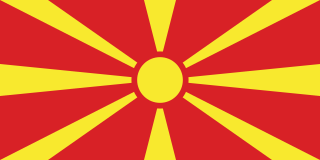 W
WThe flag of North Macedonia is the national flag of the Republic of North Macedonia and depicts a stylized yellow sun on a red field, with eight broadening rays extending from the center to the edge of the field. It was created by Miroslav Grčev and was adopted on 5 October 1995. The first flag of the country, known as the Vergina Flag, featured the Vergina Sun, a symbol that had been discovered at Aigai, the first capital and burial ground of the ancient kings of Macedon. Greece considers the Vergina Sun to be a Greek symbol and imposed a year-long economic embargo in order to force the then Republic of Macedonia to remove it from its flag, resulting in the current design. The new eight-rayed sun represents the "new sun of Liberty" referred to in "Denes nad Makedonija", the national anthem of North Macedonia.
 W
WThe national flag of Oman consists of three stripes with a red bar on the left that contains the national emblem of Oman.
 W
WThe flag of Primorsky Krai is a rectangular panel, divided diagonally by a white stripe and consisting of two triangles: the top one, placed at the flagpole, red and the bottom blue. In the upper corner near the shaft there is a golden image of a Ussuri tiger walking. The ratio of the width of the flag to its length is 2:3. The width of the white stripe on the shaft shall be one fifth of the entire width of the flag; the height of the tiger figure should be one fourth of the width of the flag on the pole. It is a representative, identification and legal mark, drawn up and used in accordance with the rules of vexillology. The idea of the flag was proposed by V. A. Obertas, a professor at the Institute of Architecture, FESTU.
 W
WThe flag of Puerto Rico represents and symbolizes Puerto Rico and its people.
 W
WThe flag of Sakhalin Oblast shows the white outline of Sakhalin Island and the Kuril Islands on a faded turquoise field. It was adopted on 28 November 1995.
 W
WThe flag of Tuscany is the official flag of the region of Tuscany, Italy. The flag depicts a silver Pegasus rampant on a white field between two horizontal red bands. The flag first appeared as a gonfalon on 20 May 1975 along with accompanying text Regione Toscana above the Pegasus. It was officially adopted as the flag of Tuscany on 3 February 1995.